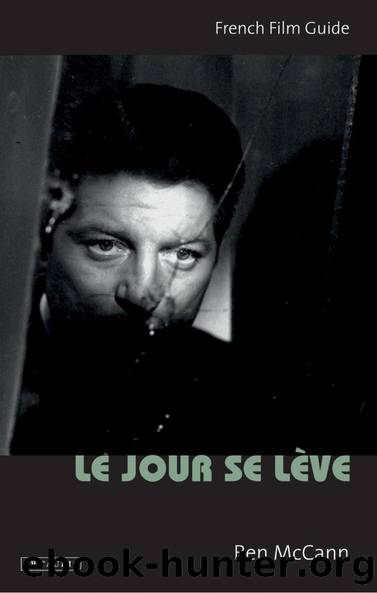Le Jour se Lève by Ben McCann

Author:Ben McCann [McCann, Ben]
Language: eng
Format: epub
Tags: Performing Arts, Film, History & Criticism
ISBN: 9780857725691
Google: MDqjDwAAQBAJ
Publisher: Bloomsbury Publishing
Published: 2014-06-10T03:33:11+00:00
Valentin âacting upâ
Stage two of Valentinâs tactics is âself-loathingâ. This self-pity is signalled by a new posture â hands unclasped, placed contritely across the arms, or stroking the chin contemplatively â and a facial gesture that involves him wrinkling his forehead and avoiding Françoisâs gaze. There is only one reaction shot of François in this section â Valentinâs performance requires his attention and ours â but when it comes, the reverse-angle shot of him is revealing. Gabinâs downturned mouth and resigned look suggest sympathy, even pity. François is himself an orphan, brought up in assistance, and so this conversation becomes, through framing and editing, a quasi-reunion between father and son. Prévertâs screenplay adds a delicious subtextual layer here â Valentin describes the eyes of Françoiseâs âmotherâ as âthe same eyes, greyish green [â¦] a colour that changes like the sea in winterâ. Like Françoisâs âsad eye and happy eyeâ, eyes here suggest duality and difference, but also, unwittingly on Valentinâs part, suggest a union between François and Françoise that we know cannot be sustained.
The final stage â âauthorityâ â culminates when Valentin brandishes his paternal authority, telling François that he does not think Françoise will be happy with him. Valentinâs use of the French subjunctive form here â âje ne pense pas quâelle puisse être heureuse avec vousâ â is a refined linguistic mark of difference that separates the two men (François responds with a contracted âTâes formidableâ [âWell, if that isnât magnificentâ], itself a specific linguistic trait). The editing, so underplayed in the earlier sections, becomes more rapid, as the cuts between the differing reactions of the two men inject pace and momentum into the scene. Now it is Françoisâs turn to seize the initiative, grabbing Valentin by the lapels and declaring his love forcefully to his surrogate father/father-in-law-to-be. François leaves, and the final two shots are of Valentin â from behind, nervously tapping his fingers against the bar table, and then in medium close-up, biting his fingernails. David Thomson writes that â[s]tars sometimes just wait, reflect and dwell on themselves in close-ups. Character actors never get that time: they have to be busyâ.8 Berryâs busyness is epitomized in this scene which, at six and a half minutes, is one of the longest in the film. His energy, his non-stop talking and his ability to shift emotions all reinforce Valentinâs malign, implacable presence. It is telling that the blind man who was the first to discover Valentinâs body at the start of the film is also in the bar-tabac at the start of this scene â fate, death and Valentin go hand in hand.
The two female performances are also important in establishing the filmâs tonal qualities and, through their interaction with their male counterparts, have revealing implications for class and sexual politics. Arletty was born Léonie Bathiat in 1898 in Courbevoie, on the outskirts of Paris, and during the 1920s became a prominent music-hall and cabaret star, famous for her richly sardonic and high-pitched voice. She worked with Carné
Download
This site does not store any files on its server. We only index and link to content provided by other sites. Please contact the content providers to delete copyright contents if any and email us, we'll remove relevant links or contents immediately.
Still Foolin’ ’Em by Billy Crystal(36251)
Spell It Out by David Crystal(36017)
The Great Music City by Andrea Baker(31242)
Professional Troublemaker by Luvvie Ajayi Jones(29566)
Trainspotting by Irvine Welsh(21477)
Call Me by Your Name by André Aciman(20342)
We're Going to Need More Wine by Gabrielle Union(18941)
The Secret History by Donna Tartt(18797)
Cat's cradle by Kurt Vonnegut(15140)
Ready Player One by Cline Ernest(14485)
Molly's Game by Molly Bloom(14042)
Bombshells: Glamour Girls of a Lifetime by Sullivan Steve(13946)
The Goal (Off-Campus #4) by Elle Kennedy(13444)
Leonardo da Vinci by Walter Isaacson(13136)
4 3 2 1: A Novel by Paul Auster(12255)
The Social Justice Warrior Handbook by Lisa De Pasquale(12117)
The Break by Marian Keyes(9282)
Crazy Rich Asians by Kevin Kwan(9144)
Adultolescence by Gabbie Hanna(8828)
